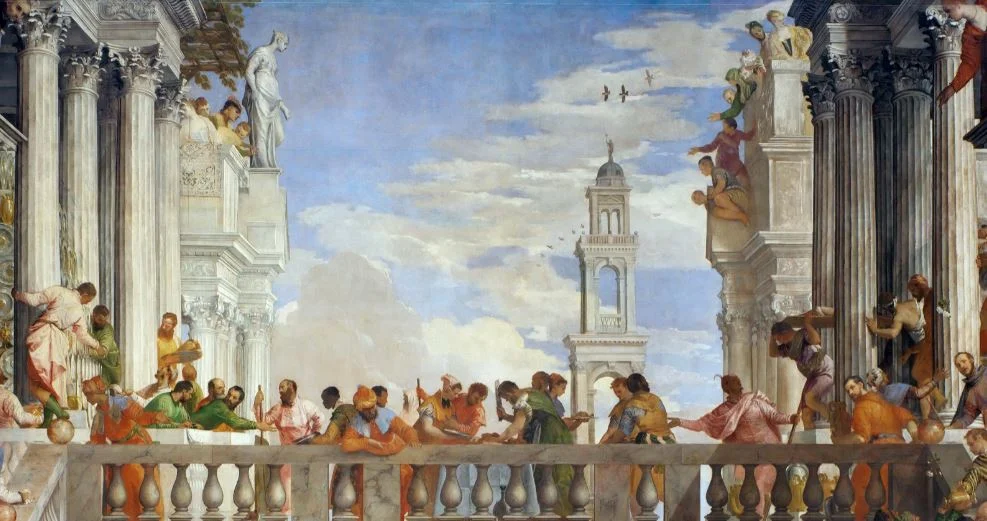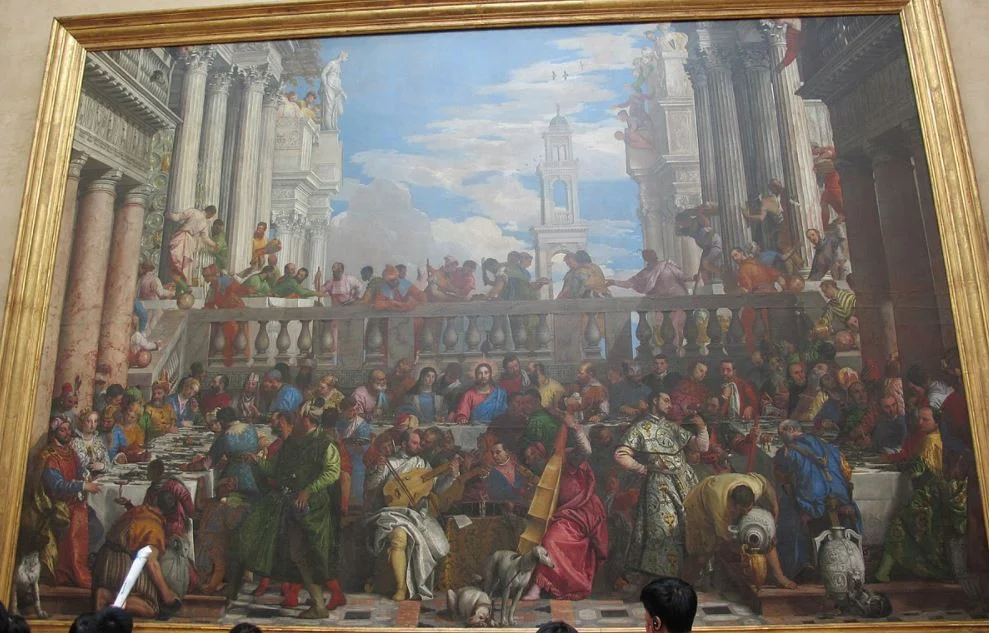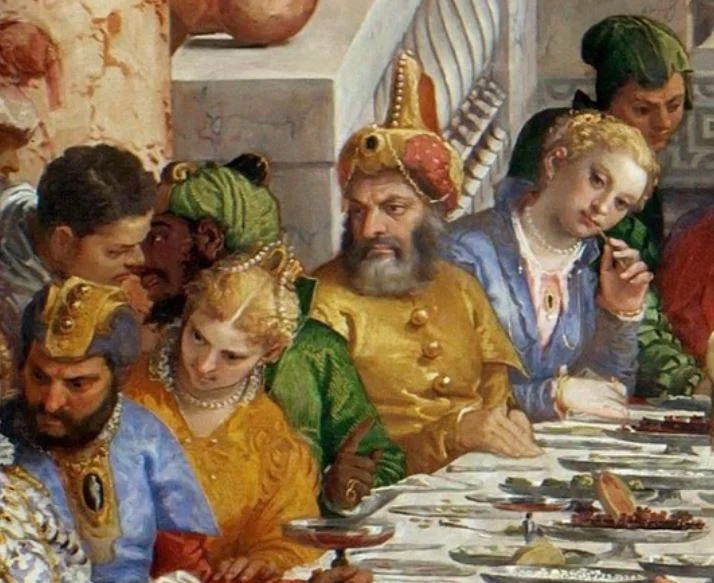When Italian artist and Mannerist painter, a period also referred to as the “Late Renaissance,” Paolo Veronese started working on one of his commissions, he spent 15 months creating an incredible masterpiece.
Let’s take a closer look at some interesting facts about The Wedding at Cana by Veronese, a work of art that can easily be described as one of the most fascinating paintings of the 16th century!
1. It was completed in the 1560s
The Wedding at Cana, also referred to as “The Wedding Feast at Cana” or “Nozze di Cana” in Italian, is a massive oil on canvas painting created by Paolo Veronese (1528-1588), one of the 3 main figures of the Venetian School of the 16th century.
The work was completed in 1563 at the height of an art movement referred to as “Mannerism“, or “High Renaissance.” The artists of this movement combined both the compositional harmony of the Renaissance with a sense of disorganization achieved by an extreme focus on light and color.
It’s fair to conclude that this painting, with its 130 table guests seated at the lower half, is the epitome of this particular art movement.

2. It was commissioned to decorate a wall of a refectory in Venice
The painting was commissioned on June 6, 1562, by the Black Monks of the Order of Saint Benedict in Venice. It was commissioned with the intent to serve as a decoration of the far wall of the new refectory at the Basilica of San Giorgio Maggiore.
The Church of San Giorgio Maggiore was built between 1566 and 1610 on the island of the same name. This church was designed by one of the leading Venetian architects of the time named Andrea Palladio in the classical Renaissance style.
The arcaded tower we see in the distance in the painting was also designed by this Italian architect.

3. It’s a representation of a famous Biblical story
The general theme of the painting is quite clear, it’s a wedding reception with numerous guests. The banquet is extremely lavish and diners are about to be served the wine which accompanies the dessert which consists of fruits and nuts.

There’s a deeper meaning behind this scene, though, because it’s a representational painting depicting one of the best-known Biblical stories, the moment Jesus Christ turns water into wine.
In the story in the Bible (John 2:1–11), Jesus, his mother Mary, and some of his Apostles visit a marriage party at Cana. During the banquet, the wine supply runs out, so upon the request of his mother, the jugs are filled with water after which Jesus turns it into wine.

4. There’s something about the composition of the painting
Even though the composition of the painting is in line with the ideals of the most famous Renaissance artists, there’s something special about the way Veronese composed it.
First of all, the painting was originally located about 2.5 meters (8.2 feet) above the refectory’s floor. This means that the viewer was forced to look at it from the bottom to the top.
Secondly, the refectory features barrel vaults, rectangular windows, and a cornice. Veronese managed to integrate the architectural elements of the top section of the painting in such a way that they were in line with the architectural elements of the refectory.
In that way, the painting became an extension of the refectory itself, a remarkable achievement!

5. Veronese was paid handsomely by the Black Monks
The contract of the commission was signed in June of the year 1562 and it made Veronese a pretty rich man as he was paid a total of 324 ducats, gold coins used during this period in time.
Apart from being paid so much money, he was also allowed to eat in the refectory and equally important, given a barrel of wine! After all, painting people who are partying with copious amounts of wine could make a 16th-century artist a bit thirsty.

6. The painting holds a remarkable record
In return for the generous commission, supplemented with a barrel of wine, the Black Monks were very particular about the work. Most importantly, they wanted it to be monumental in scale so it covered the entire refectory wall.
This means that it has dimensions of 6.77 × 9.94 meters (267 × 391 inches), which makes it the biggest painting in the collection of the Louvre Museum in Paris, a fascinating record!

7. It’s an exaggeration of the ideals of the High Renaissance
Being this monumental didn’t allow the artist to focus on one of the main elements of the High Renaissance, human figures of ideal proportions. Regardless of the overall harmonious balance of the composition, the painting features way more figures than the average Renaissance painting.
That’s why The Wedding at Cana by Veronese has been the subject of debate, starting as early as the 17th century. Both sides of the argument have a point, as fewer figures allow to focus on the main protagonists, and a large number of people allows the painter to develop multiple sub-themes.
Either way, the painting combines the ideals of Mannerism, the focus on color, and the perspective of light, with the ideals of the High Renaissance, a harmonized composition.

8. Numerous important people were included in the painting
Including a large number of people allowed Veronese to use his unique creativity to include various famous people. After all, there are 130 people depicted in the bottom section of the painting alone, so he had plenty of room for this.
Some of these famous people (among others) are:
- Eleanor of Austria,
- Francis I of France
- Mary I of England
- Suleiman the Magnificent, tenth sultan of the Ottoman Empire
- Holy Roman Emperor Charles V
- Poetess Vittoria Colonna
- Diplomat Marcantonio Barbaro
- Architect Daniele Barbaro
- Poet Pietro Aretino

9. Veronese also included himself along with his famous colleagues
One of the most remarkable facts about The Wedding at Cana is that the painter also included himself, along with the two other leading painters of the Venetian School of the 16th century.
Veronese is the man in the center dressed in white while playing the viola da braccio. The other two painters are Tintoretto, who is playing the same instrument, and Titian, who is dressed in red and plays the violin.
It also appears that Veronese already drunk a bit of his barrel of wine the way he is depicted.

10. There are multiple symbolic elements included in the painting
Apart from the overall theme, the Biblical story in which Jesus turns water into wine, there are some other symbolic elements included in the painting as well.
- The contrast of light and shadow on the vertical axis of the painting symbolizes life and death, referring to the transitionary pleasures of life on earth.
- The blade of the butcher above Jesus is directly aligned with him referring to his sacrifice as the Lamb of God.
- There’s an hourglass in front of the musicians, a reference to the futility of human vanity as everybody’s time on earth is limited.
The religious figures, including Jesus Christ and his mother Mary, have switched positions with the bride and groom as well. They are sitting on the far side of the table’s right-wing as mere guests.

11. The painting was stolen by the French in the late 18th century
Upon completion, the painting was hung on its intended location and decorated the wall of the refectory for a total of 235 years. In the year 1797, the French Revolutionary Army, under the command of Napoleon, stole the painting and brought it to Paris by cutting the canvas and rolling it up.
It ended up being stored at the Louvre Museum in Paris which was temporarily referred to as the “Musée Napoléon.”
Many of these stolen works of art were eventually returned to Italy after the Napoleonic Wars, but The Wedding at Cana was remarkably not included. The negotiator, Neoclassical sculptor Antonio Canova, was convinced that the painting was too fragile to travel to Venice, so it wasn’t added to the list of paintings to be repatriated.
That’s why the painting is still on public display at the Louvre in the “Mona Lisa room (711)” today!

12. A digital version of the painting hangs in the refectory today
While the real painting was never returned to Venice, the Louvre Museum did put in some effort in 2007 to make things right, kinda. They sponsored the creation of a digital version of the painting, 210 years after it was looted by the army of Napoleon.
This digital version, a copy referred to as a digital facsimile, was created by Factum Arte, Madrid, and consists of 1,591 graphic elements which make up the complete composition.
Because of this, the original decoration of the refectory’s wall can still be admired there today!

